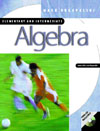 |  Elementary and Intermediate Algebra Mark Dugopolski,
Southeastern Louisiana University
Functions
Chapter 11 - Functions| The various types of functions are defined and graphed, including linear and constant functions, absolute value functions, quadratic functions, and square root functions, and the vertical-line test for a function is described. Then the various transformations of graphs are surveyed, including reflecting, translating, stretching, and shrinking. You will then be taught the various ways of combining functions to obtain new functions, including the four basic arithmetic operations, as well as composition of functions. The inverse of a function is defined, and you will learn how to identify inverse functions using the switch-and-solve strategy. The need to use special care in finding inverses for functions that involve even roots or even powers is explained. Functions that are customarily expressed in terms of variation are then discussed, with a look at direct variation, inverse variation, joint variation, and other types. The chapter concludes with a section on synthetic division, the Factor Theorem, and the application of these tools in solving polynomial equations. |
|



 2002 McGraw-Hill Higher Education
2002 McGraw-Hill Higher Education